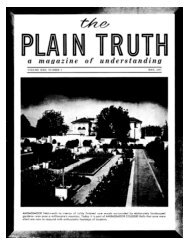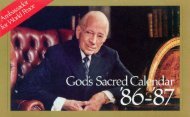The Biblical Basis of the Sacred Calendar Part One
The Biblical Basis of the Sacred Calendar Part One
The Biblical Basis of the Sacred Calendar Part One
Create successful ePaper yourself
Turn your PDF publications into a flip-book with our unique Google optimized e-Paper software.
35. This statement by <strong>the</strong> Jewish Encyclopedia notwithstanding: "<strong>The</strong>re was at least <strong>the</strong> possibility<br />
<strong>of</strong> experts discovering <strong>the</strong> small sickle <strong>of</strong> <strong>the</strong> moon six hours after <strong>the</strong> [mean] conjunction; and this<br />
possibility justified <strong>the</strong> authors <strong>of</strong> <strong>the</strong> calendar in fixing <strong>the</strong> day <strong>of</strong> <strong>the</strong> molad as <strong>the</strong> first <strong>of</strong> <strong>the</strong> new<br />
month, if <strong>the</strong> molad took place before noon" ("<strong>Calendar</strong>", p. 503). In fact, this simply justified <strong>the</strong><br />
identification <strong>of</strong> <strong>the</strong> Rabbinic and <strong>the</strong> calculated calendars (whereas <strong>the</strong>y are not <strong>the</strong> same in<br />
principle).<br />
36. "Proceedings [<strong>of</strong> <strong>the</strong> Sanhedrin] were at times deliberately prolonged or speeded up, with <strong>the</strong><br />
occasional choice <strong>of</strong> some observational post favorable for early sighting <strong>of</strong> <strong>the</strong> new crescent (Ein<br />
Tov), in order to avoid whenever possible a festival day, especially <strong>the</strong> Day <strong>of</strong> Atonement, falling<br />
immediately before or after <strong>the</strong> Sabbath. In keeping with this, <strong>the</strong> number <strong>of</strong> <strong>the</strong> full months varied<br />
between four and eight in <strong>the</strong> common, and between four and nine in <strong>the</strong> leap years, with 352-6<br />
days in 12 lunar months, variations greatly in excess <strong>of</strong> those in <strong>the</strong> present calendar" ("<strong>Calendar</strong>",<br />
Judaica, col. 49). ( <strong>The</strong> phrase "Ein Tov" or `eyn tov, "good eye", refers to <strong>the</strong> location most<br />
favorable for sighting <strong>the</strong> new crescent, not to <strong>the</strong> new crescent itself.)<br />
37. Some writers allege that Postponement Rule 1 in our received calendar grew out <strong>of</strong> a simpler<br />
postponement rule in <strong>the</strong> Rabbinic calendar (i.e., Tishri 1 cannot fall on <strong>the</strong> fourth or sixth days <strong>of</strong><br />
<strong>the</strong> week). (Cf. "<strong>Calendar</strong>", Judaica, col. 50.) But this and many o<strong>the</strong>r assumptions made by Jewish<br />
and o<strong>the</strong>r students <strong>of</strong> <strong>the</strong> sacred calendar beg <strong>the</strong> question <strong>of</strong> how an unsystematic, empirical<br />
calendar (based on one set <strong>of</strong> principles) could have "evolved" into a systematic, <strong>the</strong>oretical<br />
calendar (based on ano<strong>the</strong>r set <strong>of</strong> principles).<br />
38. This verse describes <strong>the</strong> Sabbath as shabbat shabbaton, "a sabbath <strong>of</strong> solemn rest" - a phrase<br />
which will become relevant shortly, when we examine Leviticus 23.<br />
39. Besides this, <strong>the</strong> first Day <strong>of</strong> Unleavened Bread would fall on <strong>the</strong> sixth day <strong>of</strong> <strong>the</strong> week, which it<br />
never does now; but since it can also fall on <strong>the</strong> first day on occasion, this would not be a serious<br />
change.<br />
40. <strong>The</strong> Bible describes <strong>the</strong> Sabbath, Festivals and Holy Days in a number <strong>of</strong> ways. Some <strong>of</strong> <strong>the</strong>se<br />
descriptions apply to all God's "feasts" (mo`adim); o<strong>the</strong>rs do not. For example, <strong>the</strong> Sabbath,<br />
Festivals and Holy Days are all called "holy convocations" (miqra`ê qodesh); but only Passover,<br />
Unleavened Bread, Pentecost and Tabernacles are each called chag (also translated "feast", but<br />
signifying a seasonal pilgrimage festival). <strong>The</strong> interrelationship <strong>of</strong> certain o<strong>the</strong>r terms gives us a vital<br />
key to unlocking <strong>the</strong> biblical reason behind Rule 1 (see main text below).<br />
41. Modern popular Judaism, though, links <strong>the</strong> seventh day <strong>of</strong> Tabernacles ra<strong>the</strong>r than <strong>the</strong> Last<br />
Great Day to <strong>the</strong> "last judgment". In Second Temple times, <strong>the</strong> Last Great Day (called Sheminit<br />
Atseret by <strong>the</strong> Jews, based on 2 Chronicles 7:9 and o<strong>the</strong>r verses) was a day devoted to prayer for<br />
rain.<br />
42. <strong>One</strong> could say: "All Sabbaths are equal, but some are more equal than o<strong>the</strong>rs."<br />
43. Of which <strong>the</strong> opening night is called "a night to be much observed" in Exodus 12:42 (KJV) and<br />
<strong>the</strong> night <strong>of</strong> "passover" in Deuteronomy 16:2-7. But again, this o<strong>the</strong>r "passover" relates to <strong>the</strong><br />
sacrifice <strong>of</strong> a bullock in <strong>the</strong> sanctuary on <strong>the</strong> night <strong>of</strong> Abib/Nisan 15, not <strong>of</strong> a lamb at home on <strong>the</strong><br />
night <strong>of</strong> Abib/Nisan 14.<br />
44. Reasonably, one could also prepare food on <strong>the</strong> o<strong>the</strong>r spring Holy Days, especially Pentecost<br />
(which always follows <strong>the</strong> weekly Sabbath). This would explain why none are called shabbaton, and<br />
why all <strong>of</strong> <strong>the</strong>m may fall back-to-back with <strong>the</strong> weekly Sabbath.<br />
45. <strong>The</strong>se postponements (<strong>the</strong> statements <strong>of</strong> Arthur Spier in <strong>The</strong> Comprehensive Hebrew <strong>Calendar</strong>,<br />
p. 15, notwithstanding) are nei<strong>the</strong>r "exceptions to <strong>the</strong> rule" nor "<strong>the</strong> rule", but <strong>the</strong> hierarchical<br />
application <strong>of</strong> additional rules to <strong>the</strong> calendar. In <strong>the</strong> parlance <strong>of</strong> modern technology, <strong>the</strong> date <strong>of</strong><br />
Molad Tishri is <strong>the</strong> "default position" <strong>of</strong> Tishri 1 (Trumpets). When circumstances require it, one or<br />
more postponements are applied in a particular order. Thus "in more than 60% <strong>of</strong> all years<br />
[Trumpets] does not occur on <strong>the</strong> day <strong>of</strong> <strong>the</strong> Molad Tishri but is postponed according to one <strong>of</strong> <strong>the</strong><br />
[postponement rules]" (loc. cit.). It is not <strong>the</strong> frequency, however, but <strong>the</strong> motivation <strong>of</strong> this<br />
circumstance that determines what is <strong>the</strong> "rule".
















